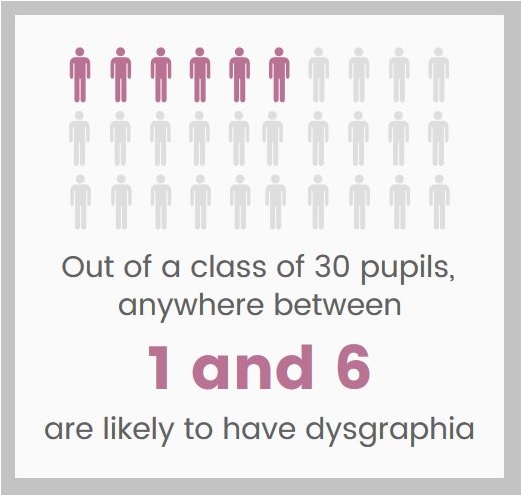Help Your Special Needs Children Thrive: Identify Common Signs Of Dysgraphia
19th August 2024

Are you concerned about your special needs child's handwriting or writing skills?
Dysgraphia, a learning disorder that affects writing abilities, can be challenging to identify. Understanding the common signs of dysgraphia in children is crucial for early detection and support. Because according to a recent study, out of a class of 30 pupils, 1 out of 6 students are likely to have dysgraphia.

Source: twitter.com
By recognizing these symptoms, every special needs teacher, parent, and even caregiver can take steps to help your child overcome writing difficulties and thrive academically.
In this blog post, we will get to learn about the common signs of dysgraphia and how to spot them in your child's everyday activities. We'll also explore the various symptoms of dysgraphia, from inconsistent letter formation to struggles with spelling and organizing thoughts on paper and some of the effective strategies as well.
Before you move to the topic, can we ask you a quick question? Do you follow us on Social Media? If not, then you’re missing out on a lot of informative content. We regularly share upgraded educational content, tips, feedback, and more. Check us out by clicking the profiles here - Facebook / Twitter / LinkedIn / Pinterest / Instagram / YouTube
Understanding Dysgraphia
Dysgraphia is a brain-based learning disorder that affects your child's writing and fine motor skills. It's a neurological condition that goes beyond just "bad handwriting." Children with dysgraphia struggle to turn their thoughts into written language at the same level of complexity as their typically developing peers. This disorder can impact handwriting, spelling, and overall written expression.
Types of Dysgraphia
There are five main types of dysgraphia:
- Dyslexic dysgraphia
- Motor dysgraphia
- Spatial dysgraphia
- Phonological dysgraphia
- Lexical dysgraphia
Each type presents differently, affecting various aspects of writing. For example, spatial dysgraphia involves difficulty with properly spacing letters and words, while motor dysgraphia stems from underdeveloped fine motor skills. It's important to note that a child can have more than one type of dysgraphia.
Dysgraphia Prevalence in Children
Dysgraphia is relatively common, with estimates suggesting that 5% to 20% of children may have this condition. The wide range is due to the fact that dysgraphia often goes undiagnosed or misdiagnosed. Symptoms can vary from mild to severe, existing on a spectrum. Interestingly, dysgraphia is more common in boys than in girls.
Additionally, there's a high prevalence of dysgraphia in children with ADHD, ADD, or autism spectrum disorder (ASD), although these conditions can also occur independently.
Common Signs of Dysgraphia
Handwriting Difficulties
You might notice your child struggling with letter formation and spacing. They may have trouble staying within lines or margins, and their handwriting can be illegible. Watch for inconsistent letter sizes, a mix of uppercase and lowercase letters, and difficulty with cursive writing. Your child may also complain of hand pain or fatigue when writing, often adopting an awkward grip on their pencil.
Spelling and Grammar Issues
Children with dysgraphia often have poor spelling skills, even if their reading abilities are normal. You may see frequent errors in their written work, including missing letters or words. Grammar and sentence structure can be challenging for them when writing, although they may express themselves well verbally.
Slow Writing Speed
Writing can be a laboriously slow process for children with dysgraphia. They may take much longer than their peers to complete written assignments. This slowness often leads to unfinished work or reluctance to engage in writing tasks.
Inconsistent Letter Formation
You might observe your child forming letters differently each time they write. Their handwriting may lack consistency in style, slant, and shape. This inconsistency can make their writing hard to read and understand. Additionally, they might struggle with copying text accurately, often making more mistakes in the copied version than the original.
Effective Strategies For Supporting Children With Dysgraphia
Let’s get to know some of the effective strategies for supporting children with Dysgraphia:
Provide Necessary Accommodations: You can consider modifying their assignments to either reduce their writing load or encourage them for alternative writing types like- typing.
Utilize Assistive Technology: You can use different assistive technological aids like- speech-to-text software or graphic organizers to reduce the stress of writing skills and handwriting.
Teach Them To Express & Write: You can focus on specific writing skills to help your special needs students improve their handwriting and express their thoughts by organizing it.
Gain a Proper Understanding Dysgraphia In Children
Recognizing the signs of dysgraphia in children is crucial to provide timely support and intervention. By keeping an eye out for handwriting difficulties, spelling and grammar issues, slow writing speed, and inconsistent letter formation, parents and educators can spot potential problems early on. This awareness has a significant impact on a child's academic journey, enabling them to get the help they need to overcome writing challenges and thrive in their studies and beyond.
If you also want to learn more effective teaching strategies and methods to support your special needs children. Then, consider pursuing courses like Online special education programs, where you will get assistance from top expert trainers.
We believe education should be accessible for everyone. That’s why we don’t charge for our blogs. Find the right course that will help you in your career with us, contact us at - 1800–212–6400. You can mail us at act@asiancollegeofteachers.com.








